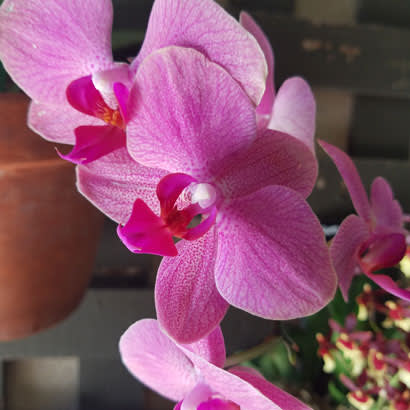
Our parks are treasures of civic life, filled with history, culture and a great proliferation of plants and animals. More than anything, however, they are places to explore and experience. From rustic landscapes to the color and fragrance of botanical gardens, parks engage our senses. As a park ranger, I wondered how I could make our resources not only more accessible to special needs patrons, but also more richly experiential to them.
The “Sense Tour,” an interactive journey through plant life, where fragrance, texture and color engage memory care patients and the partially sighted, was the result of my reflection. With a bit of easy planning, it is a program that can be presented either in the park or at the facilities where participants receive care and services, making the beauty of the environment a wonderful experience for all.
A Brief Overview
I began by reaching out to care facilities close to the park, contacting their program coordinators who schedule activities, such as art lessons, music performances, lectures and other forms of therapeutic services. They offered suggestions about how to develop a specialized plant program presentation, centered around their clients’ remaining senses and abilities. For each presentation, I transported plants from our nursery to the client’s activity room, arranging scented geraniums, lavender and rosemary on folding tables. Additional specimens of coastal sage, laurel sumac, flattop buckwheat and other plants native to the coastal chaparral helped to create a more authentic representation of the park.
Patrons generally were seated in a semicircle and received the pots and cuttings directly in their hands. Each patron was invited to touch the plants, enjoy their fragrance and describe the impressions that came to mind. When caregivers were present, participants could be led to each specimen, one by one. On a few occasions, we could transport everyone to the park’s botanical building for a guided tour of the exhibits. The emphasis, regardless of the setting, was on creating an experience and inviting patrons to tell their own stories about the feel and fragrance of plants.
At the blind center, where most clients had remnants of vision, we focused on storytelling, creating narrative descriptions of plants that emphasized the color, fragrance, texture and shape of each specimen. Some of the older participants recalled childhood memories and shared stories with us, while others created their own word paintings, describing the richness and beauty of the plants, from a deeply experiential level.
Program planning in this area tends to be more individualized and involves gauging the cognitive abilities and interest level of each person as the presentation unfolds. For this reason, it is helpful to work closely with caregivers, inviting them to assist and use their specialized knowledge of each patient to keep things moving harmoniously. Without a doubt, the Sense Tour is a team effort, with caregivers and staff members playing a central role, especially when patrons have diminished cognitive abilities.
With slight modifications, the Sense Tour also works well for memory care patients. In this setting, I try to solicit input from the audience but most responses initially come from staff members, who then prompt patients to share their own stories. From there, I invite each participant to handle and smell the various plants, encouraging everyone to share their impressions, either verbally or through drawing exercises. Overall, the goal is simple: interaction, sensory input and diversion from the daily routine. The event always proves to be enjoyable for patients as well as for staff members.
Summary
For blind community centers, as well as memory care facilities, the Sense Tour creates an opportunity for patrons to experience the park in a familiar and reassuring environment, where they are surrounded by companions and caregivers. It provides an opportunity for people with limited mobility to interact and share. In the best-case scenario, the program can provide caregivers with material for future therapeutic services and a chance to incorporate natural elements into the participants’ daily routines.
Tips for Conducting a Sense Tour
1. Contact program coordinators from local blind community centers and memory care facilities to inquire about the kinds of services they offer; ask how a plant program can be incorporated into their schedule.
2. Compile a list of potted plants you can acquire from your nursery or arboretum and gather cuttings from the park. Scented geraniums, herbs, succulents and pine branches are excellent resources for the program.
3. Work with the center’s staff members to arrange the plants on tables so participants can enjoy being in a park-like environment. You can also use art supplies to incorporate drawing activities into the program. Higher-functioning patrons will enjoy creating scrapbooks and nature collages.
4. If possible, play soft classical music in the background to help create a soothing, therapeutic atmosphere for participants.
5. Remember that caregivers and staff members will greatly appreciate your efforts and enjoy participating in the activities.
6. Don’t be afraid to improvise. The joy of the Sense Tour involves spontaneity, presenting the material in a way that encourages dialogue and creativity. Quite simply, the goal is to bring the park to those who have limited access to its beauty and to have fun in the process.
Allison M. Palmer is a Park Ranger for Balboa Park in San Diego, California.

